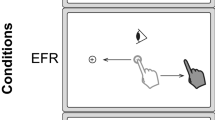Abstract
The goal of this study was to investigate whether ocular and hand motor systems operate independently or whether they share processes. Using dualtask methodology, reaction time (RT) latencies of saccadic eye and hand motor responses were measured. In experiment 1, the hand and eye motor systems produced rapid, aimed pointing movements to a visual target, which could occur either to the left or right of a central fixation point. Results showed that RT latencies of the eye response were slower in the dual-task condition than in the single-task condition, whereas the RT latencies of the hand response were virtually the same in both conditions. This interference effect indicated that the ocular and manual motor systems are not operating independently when initiating saccadic eye and goal-directed hand movements. Experiment 2 employed the same experimental paradigm as experiment 1, except for one important modification. Instead of a goal-directed hand movement to the target stimulus, subjects had to make a button-press response with either the index or middle finger of the right hand dependent upon whether the stimulus occurred to the right or left of the control fixation point. The aim of experiment 2 was to investigate the issue whether the observed interference effect in experiment 1 was specific or non-specific (e.g. overhead costs due to coordinating any two responses). The finding that saccadic eye movements and button-press responses in the dual-task condition could be initiated without delay relative to the single-task conditions, supports the specific interference interpretation.
Similar content being viewed by others
References
Abrams RA, Meyer DEM, Kornblum S (1990) Eye-hand coordination: oculomotor control in rapid aimed limb movements. J Exp Psychol 16:248–267
Biguer B, Jeannerod M, Prablanc C (1982) The coordination of eye, head and arm movements during reaching at a single visual target. Exp Brain Res 46:301–304
Carpenter RHS (1988) Movements of the eyes. Pion, London
Fischer B, Rogal L (1986) Eye-hand coordination in man: a reaction time study. Biol Cybern 55:253–261
Frens MA, Erkelens CJ (1991) Coordination of hand movements and saccades: evidence for a common and a separate pathway. Exp Brain Res 85:682–690
Gielen CCAM, Heuvel van den PJM, Gisbergen van JAM (1984) Coordination of fast eye and arm movements in a tracking task. Exp Brain Res 56:154–161
Herman R, Herman R, Maulicci R (1981) Visually triggered eyearm movements in man. Exp Brain Res 42:145–148
Paillard J (1982) The contribution of peripheral and central vision to visually guided reaching. In: Ingle D, Goodale M, Mansfield R (eds). Analysis of visual behaviour MIT Press, Cambridge pp 367–385
Prablanc C, Pelisson D (1990) Gaze saccade orienting and hand pointing are locked to their goal by quick internal loops. In: Jeannerod M (ed) Attention and performance XIII. Elsevier, North-Holland, pp 653–676
Prablanc C, Echallier JF, Komilis E, Jeannerod M (1979) Optimal response of eye and hand motor systems in pointing at a visual target. Spatio-temporal characteristics of eye and hand movements and their relationship when varying the amount of visual information. Biol Cybern 35:113–124
Prablanc C, Pelisson D, Goodale MA (1986) Visual control of reaching movements without vision of the limb 1. Role of retinal feedback of target position in guiding the hand. Exp Brain Res 62:293–302
Reulen JPH (1984) Latency of visually evoked saccadic eye movements. I. Saccadic latency and the facilitation model. Biol Cybern 50:251–262
Reulen JPH, Marcus JI, Koops D, de Vries FR, Tiesinga G, Boshuizen K, Bos JT (1988) The precise recording of eye movement: the Iris technique, part I. Med Biol Eng Comput 26:20–26
Young LR, Stark L (1963) Variable feedback experiments testing a sampled data model for eye tracking movements. IEEE Trans Hum Factors Electron 4:38–51
Author information
Authors and Affiliations
Rights and permissions
About this article
Cite this article
Bekkering, H., Adam, J.J., Kingma, H. et al. Reaction time latencies of eye and hand movements in single- and dual-task conditions. Exp Brain Res 97, 471–476 (1994). https://doi.org/10.1007/BF00241541
Received:
Accepted:
Issue Date:
DOI: https://doi.org/10.1007/BF00241541




